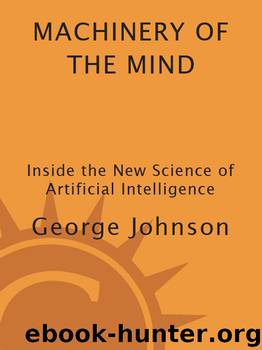Machinery of the Mind by George Johnson

Author:George Johnson [Johnson, George]
Language: eng
Format: epub
ISBN: 978-0-307-79939-5
Publisher: Crown/Archetype
Published: 2011-10-25T16:00:00+00:00
CHAPTER
9
Labyrinths
of
Memory
Research like Winston’s and Berwick’s demonstrates that learning—or at least some of its simpler aspects—can be captured with computer programs. While the systems work only in narrow and artificial domains like the blocks world, the Macbeth world, or the world of coffee cups, suitcases, bowls, and bricks, it is possible to imagine that the techniques they use could be refined and expanded. The result might be programs so advanced that they would allow a computer to grow vast conceptual mazes in its memory—huge, sprawling networks of Lisp structures in which the lines and arrows that represent the concept “cup” would be connected to those for the concept “coffee,” which would be connected to other networks capturing the fact that coffee is a liquid, that people drink liquids for pleasure, nourishment, or (if they contain caffeine) to stay awake. To enable the machine to understand the way a human does, it would need to know that coffee is made from coffee beans, which come from places like Hawaii and South America; that it’s often sold in cans in grocery stores (and must be brewed with water, which is a liquid) or is available ready-made at restaurants. All this information could be accommodated by adding more nodes and links to the semantic network, the dense web of interconnected ideas that contains everything an intelligent being knows.
Given the word “coffee” as input, this hypothetical computer could wander the streets and alleys of its memory, doing what people do when they free associate. Coffee might remind the machine of Colombia (which was named for Christopher Columbus, who, in 1492, sailed the ocean blue …) or of espresso, which is often sold in quaint little cafés called coffeehouses (which, in the 1950s, in San Francisco’s North Beach, served as meeting places for beat writers like Allen Ginsberg, who wrote “Howl,” which is a poem—see “poem”—that begins, “I saw the best minds of my generation destroyed by madness …”) or in Italian restaurants (where one can also obtain dishes containing pasta and veal, which is made by …).
Once we begin introspecting on everything in our minds that is connected to the idea of coffee, we are quickly lost in the tangle of concepts, a thicket of nodes and links. But there seems to be a logic or geography to it. In our memories, “espresso” feels close to “coffee” and “Italian restaurant” but a step removed from “pasta” and a long way from Columbus discovering America. “Ginsberg” lies relatively near to the region of San Francisco coffeehouses, farther from where we store our knowledge about “veal.” Yet each idea can be traced from one to the other. From “Howl” we can go to “howling” and “wolves” to thoughts of Alaska, or of dogs baying at the moon. Or we can go in an entirely different direction: to “beat poet” to “beat poet Gary Snyder” to “Japan,” a country he often writes about. Maybe we first heard “Howl” in a reading at a college on the plains of Nebraska, and encountering it again reminds us of the sound of wind.
Download
This site does not store any files on its server. We only index and link to content provided by other sites. Please contact the content providers to delete copyright contents if any and email us, we'll remove relevant links or contents immediately.
| Computer Vision & Pattern Recognition | Expert Systems |
| Intelligence & Semantics | Machine Theory |
| Natural Language Processing | Neural Networks |
Algorithms of the Intelligent Web by Haralambos Marmanis;Dmitry Babenko(9831)
Test-Driven Development with Java by Alan Mellor(7636)
Data Augmentation with Python by Duc Haba(7524)
Principles of Data Fabric by Sonia Mezzetta(7295)
Learn Blender Simulations the Right Way by Stephen Pearson(7215)
Microservices with Spring Boot 3 and Spring Cloud by Magnus Larsson(7048)
Jquery UI in Action : Master the concepts Of Jquery UI: A Step By Step Approach by ANMOL GOYAL(6446)
RPA Solution Architect's Handbook by Sachin Sahgal(6445)
The Infinite Retina by Robert Scoble Irena Cronin(6149)
Hadoop in Practice by Alex Holmes(6135)
Big Data Analysis with Python by Ivan Marin(5879)
Life 3.0: Being Human in the Age of Artificial Intelligence by Tegmark Max(5473)
Pretrain Vision and Large Language Models in Python by Emily Webber(4830)
Infrastructure as Code for Beginners by Russ McKendrick(4612)
WordPress Plugin Development Cookbook by Yannick Lefebvre(4331)
Functional Programming in JavaScript by Mantyla Dan(4215)
The Age of Surveillance Capitalism by Shoshana Zuboff(4207)
Embracing Microservices Design by Ovais Mehboob Ahmed Khan Nabil Siddiqui and Timothy Oleson(4103)
Applied Machine Learning for Healthcare and Life Sciences Using AWS by Ujjwal Ratan(4080)
